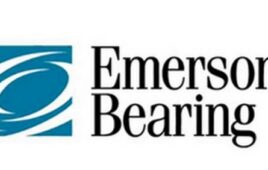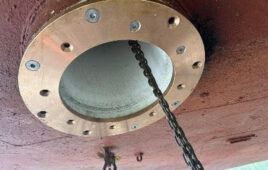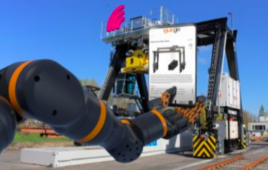Miniature ball bearings are high precision devices compared to many mechanical parts. Good performance will therefore require treatment that takes into account their characteristics and operating environment.
Handle with care. Literally. Just because bearings are built to last doesn’t mean they’re made for mistreatment. A high percentage of bearing problems, including failures, are the result of improper handling procedures. The following information represents the results of some common case studies.
Particle Contamination

The performance of miniature precision ball bearings is critically affected by minute particle contamination. Avoiding exposing the bearing to any environment where particles may be present is highly recommended.
The performance of miniature precision ball bearings is critically affected by minute particle contamination. Avoiding exposing the bearing to any environment where particles may be present is highly recommended. Shields and seals are used to prevent contaminants from reaching the inside of the bearing. However, after assembly, there is still a small gap between the shield and the inner ring. This gap may permit particle entry.
A few procedural guidelines to consider:
*Keep bearing handling rooms as clean as possible.
*Do not remove bearings from their packaging until just before use.
*When moving the bearings to a container, be sure the container is clean. The lid should be kept close, and it should be cleaned every day to prevent particle accumulation.
*Never use a bearing that has been dropped. It may be brinelled (race track dented). In use, a brinelled bearing will generate a high level of acoustic noise.
*Before applying adhesive to a bearing, use a clean cloth dampened with an alcohol agent to clean oily materials such as anti-corrosion oil from the inner and outer rings. Do not saturate the cloth excessively with the cleaning agent. The liquid agent itself could leak into the bearing, carrying particles with it.
*When applying a lubricant to the outer circumference of a bearing, make sure the lubricant is not contaminated. Contamination might inadvertently be transferred into the bearing.
*Never use an applicator that will leave contaminants on or near the bearings. A cotton swab, for instance, may leave small fibrous particles behind. A mechanical dispenser, or a clean room type of applicator is recommended.
*Do not handle bearings in a place where they could be directly exposed to outside air. Airborne contaminants include dust, dirt, and humidity.

Shields and seals are used to prevent contaminants from reaching the inside of the bearing. However, after assembly, there is still a small gap between the shield and the inner ring. This gap may permit particle entry.
Rust Contamination
Because many bearings are metallic products, they rust easily. Their treatment requires certain precautions. When handling bearings, use finger caps, tweezers or gloves that do not generate cotton fibers. When using unprotected fingers to handle a bearing, first make sure they are clean and free from perspiration and dust. Apply a quality mineral oil to the fingertips before touching the bearing; do not use hand cream, as it may induce rust.
Additionally, if a shaft is dirty on the surface, rust may gather between the shaft and the bearing after they are fitted. It is important to make sure that the shaft is free from finger prints, perspiration, dust and dirt.
Smaller details involve avoiding the storage of bearings near air conditioners and direct sunlight. Bearings may rust when placed near an air conditioner outlet, or any place where wind or sunlight can enter directly. A pronounced temperature difference may cause condensation to form on the bearings. In colder climates, allow the bearings to reach room temperature before unpacking them. The best location for storing bearings is in a centrally heated and properly ventilated environment. Varnish applied to a motor winding may also cause bearings to rust when the acid generated by varnish gas is absorbed into the grease of the bearing. Be sure to test for this condition, and be aware that changes in procedures, such as drying time changes, may affect this condition.
Shock Forces
Bearings are easily affected by shock forces. Depending on the size of the bearing, a shock force from a 100 gram weight at 4mm away could cause brinelling. Brinelling could also occur when bearings are automatically press-fitted to a rotor shaft, if the shaft and bearing bore are not kept accurately in line.
A typical example of shock causing brinelling is when motors are placed on a conveyor belt. As the motors moved through the conveyor, the movement causes the motors to hit the iron plate underneath the conveyor, resulting in shock which causes brinelling to the bearing. Holes made to the iron plate prevent this type of shock force to be generated.

Brinelling, (dents and abrasions to the raceway) as small as 0.1 micron in depth will have an adverse effect on acoustic noise levels as well as causing increased torque levels. The bearing in this image is a full 1.5mm.
Mounting Precision Bearings
When bearings are mounted incorrectly, the balls will cause brinelling on the raceway and undermine bearing performance and life. Brinelling, (dents and abrasions to the raceway) as small as 0.1 micron in depth will have an adverse effect on acoustic noise levels as well as causing increased torque levels. Several general rules apply to mounting bearings. When assembling a bearing with its shaft or housing, it is critical that no force be applied to the balls. When mounting a bearing to a shaft, always press the inner ring. When mounting a bearing into a housing, press the outer ring.
It is also important to never apply force to the outer ring when mounting a shaft, or to the inner ring when mounting into a housing; never apply a shock load in either case. When manually fitting a shaft into a bearing through its bore, do not force the shaft as it may cause brinelling to the bearing.
After gluing a bearing to a housing using a guide through the bearing bore, take the guide out carefully. When motors are being assembled, be aware that bearings may be attracted by the magnet and could slip from your fingers. To avoid this, hold the motor shaft in your palm, and cautiously insert the rotor. For automated assembly, use an air cylinder, and steadily operate the assembly.
Application Environment
The environment in which bearings are used will largely determine their life. Chlorine gas, ozone and other chemicals will shorten bearing life, as the grease will become contaminated relatively quickly. Generally, grease life will fail by half with every 10ºC to 15ºC that the ambient temperature increases. Therefore, it is critical to select the correct lubricant for the anticipated operating temperature.
NMB
www.nmbtc.com
The post Care and handling for precision ball bearings appeared first on Bearing Tips.
Filed Under: Bearings, Bearing Tips





